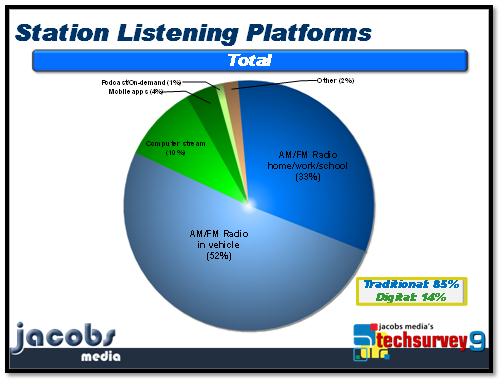One of the hot topics in radio for several years – but reaching a fascinating apex at this point in time – revolves around streaming and whether stations are getting proper credit and compensation for their audience usage numbers.
As pure-plays continue to grow their reach, as radio grapples with single-line reporting, as the automotive world moves even faster to a Wi-Fi environment, and as consumers become even more comfortable with accessing audio via streams, we are witnessing major shifts in how content is consumed even among radio’s biggest fans. Yes, FM tuners in smartphones will help broadcasters, especially as the concept expands to different carriers and handsets. But it won’t stop the speeding bullet train that is streaming – something that AM/FM radio stations need to embrace, manage, market, and ultimately monetize.
In this blog, we have urged radio to “eat its own dog food” – monitor your stream to experience it just like consumers do. But beyond the CX – or customer experience – the stream’s contribution to a radio brand’s reach and image position is a big issue.
I was reminded of this the other day while reading an article in the Wall Street Journal.  Kevin Reilly, Fox TV’s head of entertainment, was speaking in front of a group of television critics, and noted that while conventional ratings are the key measure of winners and losers, this data is “becoming increasingly a sliver of the story.”
Kevin Reilly, Fox TV’s head of entertainment, was speaking in front of a group of television critics, and noted that while conventional ratings are the key measure of winners and losers, this data is “becoming increasingly a sliver of the story.”
Reilly went on to note that TV is losing credit for viewership on DVRs, on-demand, and streaming video sites. Pointing to The Following, he noted that “the audiences are still enormous across multiple platforms.” But too many advertisers are just focused on traditional ratings.
Radio programmers and managers can relate, because in many cases, strong brands are attracting usage that goes well beyond listenership on traditional radios in cars, at work, at home, or at school. Of course, streaming is at the epicenter of additional listening. A recent eMarketer study reaffirms streaming growth, noting that by 2015, a majority of Americans will listen to Internet radio monthly.
And much of that consumption will take place on mobile devices – the other sea change facing radio brands. Over 70 million people stream audio on their smartphones in this country, a stat that should be very top-of-mind for broadcasters.
To get a better sense for how this impacts the radio business, we built a usage question into both Techsurvey9 and its companion study for public radio, PRTS5. The idea was to have respondents think back to the previous week and how they consumed content from the station that sent them the survey. We provided a list of sources and participants assigned a percentage – totaling up to 100%.
Below is the chart from Techsurvey9, and while this is recall from the past week, we’re looking at core radio listeners, most of whom are members of radio station databases. The fact that an estimated 14% of their consumption to their favorite stations’ content offerings are on the digital side of the street is telling. And of course, it varies greatly by format, running considerably higher among fans of Sports Radio and Christian music stations.  So what are the implications here? First off, the toothpaste is out of the tube. Some of radio’s biggest fans are accessing station content from computers, smartphones, and tablets – a trend that will only grow over time.
So what are the implications here? First off, the toothpaste is out of the tube. Some of radio’s biggest fans are accessing station content from computers, smartphones, and tablets – a trend that will only grow over time.
Secondly, radio needs to fully embrace the streaming platform as digital competitors actively seek out touch points, outlets, and channels.
 And finally, there’s this issue of the Three M’s – the need to more accurately measure AM/FM streaming, merge it with usage data from broadcast radio in a format that is acceptable to agencies and buyers, and then monetize these bigger numbers. That’s the Holy Grail of this rapidly integrating media world in which we live, where the need to bring ratings companies, streaming providers, agencies, and broadcasters together so that all can benefit from these changes is paramount.
And finally, there’s this issue of the Three M’s – the need to more accurately measure AM/FM streaming, merge it with usage data from broadcast radio in a format that is acceptable to agencies and buyers, and then monetize these bigger numbers. That’s the Holy Grail of this rapidly integrating media world in which we live, where the need to bring ratings companies, streaming providers, agencies, and broadcasters together so that all can benefit from these changes is paramount.
Otherwise, guys like Reilly, Westin, Weatherly, and Farley are going to continue to whine about not getting proper credit for their grand brands.
And they’ll be right.
- Media And Technology In 2025: Believe It Or Not! - April 18, 2025
- In Radio, You Just Never Know - April 17, 2025
- The Secret To Making A Great Podcast (And Great Radio) - April 16, 2025




Fred:
Relative to listening percentages, I have been asking online radio listeners these questions since 2004:
“If you label your TOTAL radio listening, what percentage of time do you spend with broadcast radio? What percentage with radio online?”
The following charts reflect results:
2004 – https://www.audiographics.com/survey_charts/survey24-percentage_comparison.gif
A 2006 to 2012 comparative:
https://www.audiographics.com/survey_charts/survey55-survey38-percentage_comparison.gif
Details on the questions in
2012 – https://www.audiographics.com/spclreport/survey55.htm
2004 – https://www.audiographics.com/spclreport/survey24.htm
Though it’s not an apples-to-apples comparision of yours – ours was asked only of online radio listeners – you may find the trend unmistakably on the side of streaming.
Ken Dardis
Audio Graphiics, Inc
Ken, thanks for the data and for contributing to the conversation. There’s no question in mind where the puck is moving (or has already moved to). I’m sure we’ll see more comments today on this big topic.
I’m amazed at how little radio has done with this issue – as the problems are the same as they’ve been for years – they’re just getting more significant by the day. Clearly, monetiziation is the big “M” here.
First, there’s the streams of terrestrial radio. It appears that (based on PPM data) that people’s recall of stream listenership is higher than reality, but it’s use is growing. Its time that Radio and AFTRA undo the crazy system where online streams are forced pay extra – so that in practice their ads are NEVER streamed…meaning everyone loses. If streams were true simulcasts, they could be incorporated into Arbitron numbers and monetized by default.
Then there is the issue of royalties. There is no business model for streaming under the current rates. Streamers are paying 60% of revenues in royalties and artists are claiming they are getting next to nothing from legal streams, so streamers and artists are a long way from being made whole.. A little give on both sides won’t be enough to result in decent ROI or happy artists.
Meanwhile, streamers are converting people in big numbers while burning through investor capital and stock on an unworkable financial structure.
Radio will need to take the lead on this, as its audience is being siphoned off into a money pit. Serious conversations with AFTRA, the music industry and artists are long overdue. I understand radio’s reluctance to convert returning assets to non returning ones – but streamers are doing it in great numbers anyway – so its imperative that radio craft a solution that will allow for reasonable monetization.
Bob, thanks for the thoughtful comments. You make a lot of great points about business models (or the lack thereof) as well as the onus being on radio to take a lead role here. There are a lot of conflicting issues and vested interests in this mix which get in the way of problem-solving and compromise. But when I see core listeners crediting this much streaming among their favorite stations (forget about how they use pure-plays and other streaming options), it’s an imperative that the industry step up and figure out how to get this done. Thanks for taking the time.
When I created the DAR.fm – the DVR for radio and had a chance to speak with industry types the #1 question was “How does Arbitron monitor this?” Instead of realizing that users are DEMANDING time shifting in all media – yes, including radio- they care only how Arbitron works or in this case doesn’t work.
Radio must go where the listeners are and let Arbitron catch up rather than wait for Arbitron to monitor new digital outlets.
Change is tough, as you know, for a legacy industry like this one. And the sales question always looms large in these discussions about streaming. There’s no question, Michael, that consumers are in control. The good news is that for great radio brands, they show up for station streams on computers and mobile devices. As always, the devil is in those digital details. Thanks for checking in with us – always appreciate your perspective.
All I can add to this conversation is the radio industry cannot fail at understanding the sea-change that is happening, not coming, but happening now with streaming. With each year the usage increases exponentially.
I was fortunate to be part of the launch of an app for the Dallas Morning News sports department that capitalized on its relationship with KTCK-AM. By adding not only a live stream of this impossibly popular station, but the ability to pause/ff/rr, when the station began to promote it – the downloads and success of the app was off the charts. It was the addition of the stream and our ability to meet this obvious demand that made this product a success.
It may be uncomfortable, painful and hard work. But this is what consumers want and expect.
The creation of high quality UX for easy streaming, be in in a native app, mobile web or desktop environment is critical to radio’s success in competing in this new world.
Peter, great perspective. Thanks for time to add more evidence to an important story.